Deck 28: Determining More Complicated Probabilities
Question
Question
Question
Question
Question
Question
Question
Question
Question
Question
Question
Question
Question
Question
Question
Question
Question
Question
Question
Question
Question
Question
Question
Question
Question
Question
Question
Question
Question
Question
Question
Question
Question
Question
Question
Question
Question

Unlock Deck
Sign up to unlock the cards in this deck!
Unlock Deck
Unlock Deck
1/37
Play
Full screen (f)
Deck 28: Determining More Complicated Probabilities
1
In tossing eight honest coins, HTHHTHTT is more probable than TTTTTTTT.
False
2
If A and B are disjoint events, then P(A or B) = P(A) + P(B).
True
3
In general for events A and B, P(A and B) = P(A) × P(B).
False
4
In families of six children, the birth order BGGBGB is more probable than the birth order GGGBBB.

Unlock Deck
Unlock for access to all 37 flashcards in this deck.
Unlock Deck
k this deck
5
A future birth order of BGBG has the same probability as does GGGG.

Unlock Deck
Unlock for access to all 37 flashcards in this deck.
Unlock Deck
k this deck
6
Experiment: Draw a ball from Box 1, note its color, and then put the ball into Box 2. Then draw a ball from Box 2 and note its color.
A) Make a condensed tree diagram for this experiment, with probabilities on the branches.

B) Write the probabilities for each outcome of the experiment. (Write them on the tree diagram in part
C) For this experiment, what is the probability of the event "the second ball is B"?
A) Make a condensed tree diagram for this experiment, with probabilities on the branches.

B) Write the probabilities for each outcome of the experiment. (Write them on the tree diagram in part
C) For this experiment, what is the probability of the event "the second ball is B"?

Unlock Deck
Unlock for access to all 37 flashcards in this deck.
Unlock Deck
k this deck
7
Three-step experiment: First, randomly choose one of the boxes described below. Then draw one marble. Without replacement, draw another marble from the same box. Note the colors of the two marbles (W = white, R = red).
Box 1 has four white marbles and two red marbles.
Box 2 has six white marbles and two red marbles.
A) Make a complete, condensed tree diagram for the experiment, including the outcomes and their probabilities.
B) What is the probability of at least one red marble?

Box 1 has four white marbles and two red marbles.
Box 2 has six white marbles and two red marbles.
A) Make a complete, condensed tree diagram for the experiment, including the outcomes and their probabilities.
B) What is the probability of at least one red marble?


Unlock Deck
Unlock for access to all 37 flashcards in this deck.
Unlock Deck
k this deck
8
For some unusual two-step experiment, only the data below are given. What is P(XZ)? Write enough (numbers, calculations, words as needed) to make your thinking clear. 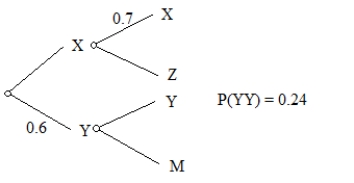


Unlock Deck
Unlock for access to all 37 flashcards in this deck.
Unlock Deck
k this deck
9
For some unusual two-step experiment, only the data below are given. What is P(XZ)? Write enough (numbers, calculations, words as needed) to make your thinking clear. 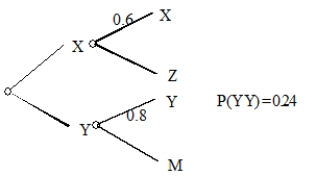


Unlock Deck
Unlock for access to all 37 flashcards in this deck.
Unlock Deck
k this deck
10
Below is a probability tree diagram for an experiment. If the probability of BD is 0.48, what is the probability of AC?



Unlock Deck
Unlock for access to all 37 flashcards in this deck.
Unlock Deck
k this deck
11
Trisha tosses three fair pennies, but you can't see what happened. She tells you, however, "One or more of the pennies came up heads." What is the probability that Trisha tossed three heads? Write enough to make your thinking clear.

Unlock Deck
Unlock for access to all 37 flashcards in this deck.
Unlock Deck
k this deck
12
Karen asked her dad for two dimes to buy gumballs for herself and her brother. (The machine gives one gumball for a dime.) There were three red gumballs, two yellow gumballs, and one green gumball in the machine. Her favorite gumball is red. She hopes that she will get at least one red gumball.
A) List all the possible outcomes she can get for the two gumballs (think carefully) and the probabilities for each.
B) What is the probability that Karen will get at least one red gumball?
C) What does your answer in part B mean?
A) List all the possible outcomes she can get for the two gumballs (think carefully) and the probabilities for each.
B) What is the probability that Karen will get at least one red gumball?
C) What does your answer in part B mean?

Unlock Deck
Unlock for access to all 37 flashcards in this deck.
Unlock Deck
k this deck
13
A) What does it mean to say that A and B are independent events?
B) Give an example of independent events.
B) Give an example of independent events.

Unlock Deck
Unlock for access to all 37 flashcards in this deck.
Unlock Deck
k this deck
14
If you pick a book at random from the Washington School library, P(red cover) = 0.2 and P(fiction) = 0.4.
A) Find P(red cover and fiction). Show your work for credit.
B) What assumption did you make in part A? Justify your assumption for this situation.
A) Find P(red cover and fiction). Show your work for credit.
B) What assumption did you make in part A? Justify your assumption for this situation.

Unlock Deck
Unlock for access to all 37 flashcards in this deck.
Unlock Deck
k this deck
15
If you buy a blouse at random from the Sands End catalog, P(blue blouse) = 0.3 and P(frilly sleeves) = 0.2.
A) Find P(blue blouse or frilly sleeves). Show your work for credit.
B) What assumption did you make in part A? Justify your assumption for this situation.
A) Find P(blue blouse or frilly sleeves). Show your work for credit.
B) What assumption did you make in part A? Justify your assumption for this situation.

Unlock Deck
Unlock for access to all 37 flashcards in this deck.
Unlock Deck
k this deck
16
Experiment: Spin Spinner 1 (below) and note the number. Then spin Spinner 2 and note the number.
A) Make a tree diagram for this experiment, with all the final outcomes and the probabilities for each outcome.
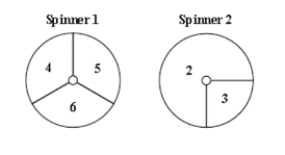
B) P(the first spin is an even number) = ______
C) P(the sum of the two spins = 7) = ______
D) P(the first spin is an even number or the sum of the two spins = 7) = ______
A) Make a tree diagram for this experiment, with all the final outcomes and the probabilities for each outcome.

B) P(the first spin is an even number) = ______
C) P(the sum of the two spins = 7) = ______
D) P(the first spin is an even number or the sum of the two spins = 7) = ______

Unlock Deck
Unlock for access to all 37 flashcards in this deck.
Unlock Deck
k this deck
17
Experiment: Spin Spinner 1 (below) and note the number. Then spin Spinner 2 and note the number.
A) Make a tree diagram for this experiment, with probabilities on the branches of the tree.

B) Give the sample space for the experiment and the associated probabilities.
C) P(the first spin is an even number) = ______
D) P(the sum of the two spins = 9) = ______
E) P(the first spin is an even number or the sum of the two spins = 9) = ______
A) Make a tree diagram for this experiment, with probabilities on the branches of the tree.

B) Give the sample space for the experiment and the associated probabilities.
C) P(the first spin is an even number) = ______
D) P(the sum of the two spins = 9) = ______
E) P(the first spin is an even number or the sum of the two spins = 9) = ______

Unlock Deck
Unlock for access to all 37 flashcards in this deck.
Unlock Deck
k this deck
18
A) Make a condensed tree diagram for this experiment. Spin and then select one ball from the box designated by the spinner. Record the outcomes and their probabilities. 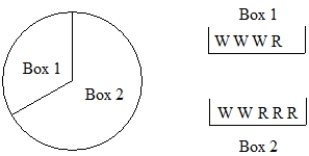
B) What is the probability of drawing an R?

B) What is the probability of drawing an R?

Unlock Deck
Unlock for access to all 37 flashcards in this deck.
Unlock Deck
k this deck
19
Experiment: Spin the spinner below and note the number. Then spin the spinner again and note the number. 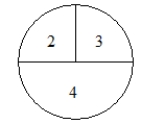
A) Give the sample space for the whole experiment.
B) P(first spin gives 3) = ______
C) What does your answer in part B mean? (If you can't answer part B, use a fake answer for it to answer part c.)
D) P(the sum of the two numbers = 6) = ______

A) Give the sample space for the whole experiment.
B) P(first spin gives 3) = ______
C) What does your answer in part B mean? (If you can't answer part B, use a fake answer for it to answer part c.)
D) P(the sum of the two numbers = 6) = ______

Unlock Deck
Unlock for access to all 37 flashcards in this deck.
Unlock Deck
k this deck
20
A box has 3 green balls (G) and 2 red balls (R). Experiment: Draw a ball and note its color. Do not put it back. Draw again and note the color.
A) Make a condensed tree diagram for the experiment, complete with probabilities for the outcomes.
B) What is the probability that the two balls drawn are the same color?
A) Make a condensed tree diagram for the experiment, complete with probabilities for the outcomes.
B) What is the probability that the two balls drawn are the same color?

Unlock Deck
Unlock for access to all 37 flashcards in this deck.
Unlock Deck
k this deck
21
Suppose that in your work you often deal with complicated events, as in the drawing below. (The circular regions show events.) Write a formula for how you could calculate P(A or B or C), using simpler probabilities like P(A) and so on. 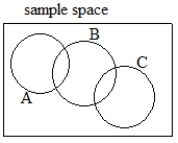


Unlock Deck
Unlock for access to all 37 flashcards in this deck.
Unlock Deck
k this deck
22
Suppose that in your work you often deal with complicated events as in the drawing below. Write a formula for how you could calculate P(A or B or C), using simpler probabilities like P(A) and so on. 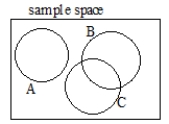


Unlock Deck
Unlock for access to all 37 flashcards in this deck.
Unlock Deck
k this deck
23
Give a formula for P(A or B or C) for events like those shown below, using simpler probabilities like P(A) and so on. 


Unlock Deck
Unlock for access to all 37 flashcards in this deck.
Unlock Deck
k this deck
24
For events A and B, if P(A) = 0.2 and P(B) = 0.4, then P(A or B) = 0.6.

Unlock Deck
Unlock for access to all 37 flashcards in this deck.
Unlock Deck
k this deck
25
HHHHHHHHHHHH is impossible with 12 tosses of an honest coin.

Unlock Deck
Unlock for access to all 37 flashcards in this deck.
Unlock Deck
k this deck
26
If events A and B are independent with P(A) = 0.4 and P(B) = 0.2, then P(A and B) = 0.8.

Unlock Deck
Unlock for access to all 37 flashcards in this deck.
Unlock Deck
k this deck
27
If A and B are not disjoint events, then P(A or B) < P(A) + P(B).

Unlock Deck
Unlock for access to all 37 flashcards in this deck.
Unlock Deck
k this deck
28
If A and B are independent events, P(A or B) = P(A) + P(B) - P(A) ° P(B).

Unlock Deck
Unlock for access to all 37 flashcards in this deck.
Unlock Deck
k this deck
29
The probability of guessing correctly on all of five true-false questions is

Unlock Deck
Unlock for access to all 37 flashcards in this deck.
Unlock Deck
k this deck
30
Complete the following formulas for special cases, using the most concise answers. (Do not include any unnecessary probabilities.)
A) If A and B are disjoint events, then P(A or B) = _____.
B) If A and B are disjoint events, then P(A and B) = _____.
A) If A and B are disjoint events, then P(A or B) = _____.
B) If A and B are disjoint events, then P(A and B) = _____.

Unlock Deck
Unlock for access to all 37 flashcards in this deck.
Unlock Deck
k this deck
31
In a certain game you toss two dice. If you roll a 6, you can start the game, and if you roll doubles (both dice with the same number of dots on top), you get an extra turn. Jody is hoping that he will roll a 6 and also get doubles on his next turn. Select the best answer for each item below and explain why you chose that response.
A) Rolling a 6 and rolling doubles are: INDEPENDENT NOT INDEPENDENT
B) Rolling a 6 and rolling doubles are: DISJOINT NOT DISJOINT
A) Rolling a 6 and rolling doubles are: INDEPENDENT NOT INDEPENDENT
B) Rolling a 6 and rolling doubles are: DISJOINT NOT DISJOINT

Unlock Deck
Unlock for access to all 37 flashcards in this deck.
Unlock Deck
k this deck
32
A school tried out two curricula, P and Q, with a total of 200 children. 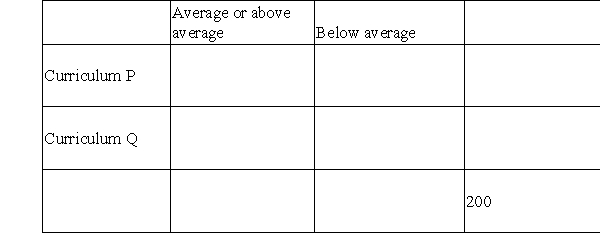
A) 60% of the 200 children studied curriculum P. Enter that number of children in the appropriate place in the contingency table.
B) 30% of all the children scored below average on the state test. Enter that number of children in the appropriate place in the table.
C) of the curriculum Q children scored below average. Enter that number of children in the appropriate place in the table.
of the curriculum Q children scored below average. Enter that number of children in the appropriate place in the table.
D) Given that a child studied curriculum P, what is the probability that the child scored average or above average on the state test?
E) Given that child studied curriculum Q, what is the probability that the child scored average or above average on the state test?

A) 60% of the 200 children studied curriculum P. Enter that number of children in the appropriate place in the contingency table.
B) 30% of all the children scored below average on the state test. Enter that number of children in the appropriate place in the table.
C)
 of the curriculum Q children scored below average. Enter that number of children in the appropriate place in the table.
of the curriculum Q children scored below average. Enter that number of children in the appropriate place in the table.D) Given that a child studied curriculum P, what is the probability that the child scored average or above average on the state test?
E) Given that child studied curriculum Q, what is the probability that the child scored average or above average on the state test?

Unlock Deck
Unlock for access to all 37 flashcards in this deck.
Unlock Deck
k this deck
33
Two similar cities tried out two programs, P and Q, to cut down on the use of tobacco. They tested the programs with a total of 2000 junior high students. 
A) 60% of the 2000 students were in program P. Enter that number of students in the appropriate place in the contingency table.
B) 30% of all the students used tobacco more. Enter that number of students in the appropriate place in the table.
C) of the program Q students used tobacco more. Enter that number of children in the appropriate place in the table.
of the program Q students used tobacco more. Enter that number of children in the appropriate place in the table.
D) Given that a student was in program P, what is the probability that the student used tobacco less or the same?
E) Given that a student was in program Q, what is the probability that the student used tobacco less or the same?

A) 60% of the 2000 students were in program P. Enter that number of students in the appropriate place in the contingency table.
B) 30% of all the students used tobacco more. Enter that number of students in the appropriate place in the table.
C)
 of the program Q students used tobacco more. Enter that number of children in the appropriate place in the table.
of the program Q students used tobacco more. Enter that number of children in the appropriate place in the table.D) Given that a student was in program P, what is the probability that the student used tobacco less or the same?
E) Given that a student was in program Q, what is the probability that the student used tobacco less or the same?

Unlock Deck
Unlock for access to all 37 flashcards in this deck.
Unlock Deck
k this deck
34
In a polling of 400 parents, 20% were high income. One hundred and sixty low-income parents supported vouchers, and 50 high-income parents opposed vouchers. (Hint: Make a table before answering the questions.)
A) What is P(oppose vouchers | high income)? (That is, what is the probability that a parent opposes vouchers, given that the parent has high income?)
B) What is P(high income | oppose vouchers)?
C) What is the probability that a parent has high income OR opposes vouchers?
A) What is P(oppose vouchers | high income)? (That is, what is the probability that a parent opposes vouchers, given that the parent has high income?)
B) What is P(high income | oppose vouchers)?
C) What is the probability that a parent has high income OR opposes vouchers?

Unlock Deck
Unlock for access to all 37 flashcards in this deck.
Unlock Deck
k this deck
35
Of 100 students randomly sampled, 40 are female and 60 are male. A fourth of the females say yes when asked if they have ever driven more than 90 miles/hour, the others say no. But two-thirds of the males say they have and only one-third say no. (Hint: Make a table before answering the questions.)
A) What is the probability that a student chosen at random will say yes to the question?
B) What is the probability that the student is female, given that the student says yes?
C) What is the probability that the student says yes and is female?
D) What is the probability that the student says yes or the student is female (or both)?
A) What is the probability that a student chosen at random will say yes to the question?
B) What is the probability that the student is female, given that the student says yes?
C) What is the probability that the student says yes and is female?
D) What is the probability that the student says yes or the student is female (or both)?

Unlock Deck
Unlock for access to all 37 flashcards in this deck.
Unlock Deck
k this deck
36
A company has collected data on the numbers of male and female employees who did or did not graduate from college. The data are summarized below. (Hint: Make a table before answering the questions.)
If an employee is selected from this company, find the following probabilities.
If an employee is selected from this company, find the following probabilities.
A) P(female and college graduate)
B) P(female or college graduate)
C) P(female | college graduate)
D) P(college graduate | female)
If an employee is selected from this company, find the following probabilities.

If an employee is selected from this company, find the following probabilities.
A) P(female and college graduate)
B) P(female or college graduate)
C) P(female | college graduate)
D) P(college graduate | female)

Unlock Deck
Unlock for access to all 37 flashcards in this deck.
Unlock Deck
k this deck
37
Here are data for one community for a year. (Hint: Make a table before answering the questions.) 
A) Assuming that the data in the table are typical, what is the probability of a driver having one or more car crashes in a year?
B) Is the probability in part A theoretical or experimental? Explain briefly.
C) What is the probability that the driver is male, given that the driver is in a car crash?
D) What is the probability that the driver is in a car crash, given that the driver is male?
E) What is P(is in one or more car crashes OR is a male)?

A) Assuming that the data in the table are typical, what is the probability of a driver having one or more car crashes in a year?
B) Is the probability in part A theoretical or experimental? Explain briefly.
C) What is the probability that the driver is male, given that the driver is in a car crash?
D) What is the probability that the driver is in a car crash, given that the driver is male?
E) What is P(is in one or more car crashes OR is a male)?

Unlock Deck
Unlock for access to all 37 flashcards in this deck.
Unlock Deck
k this deck



